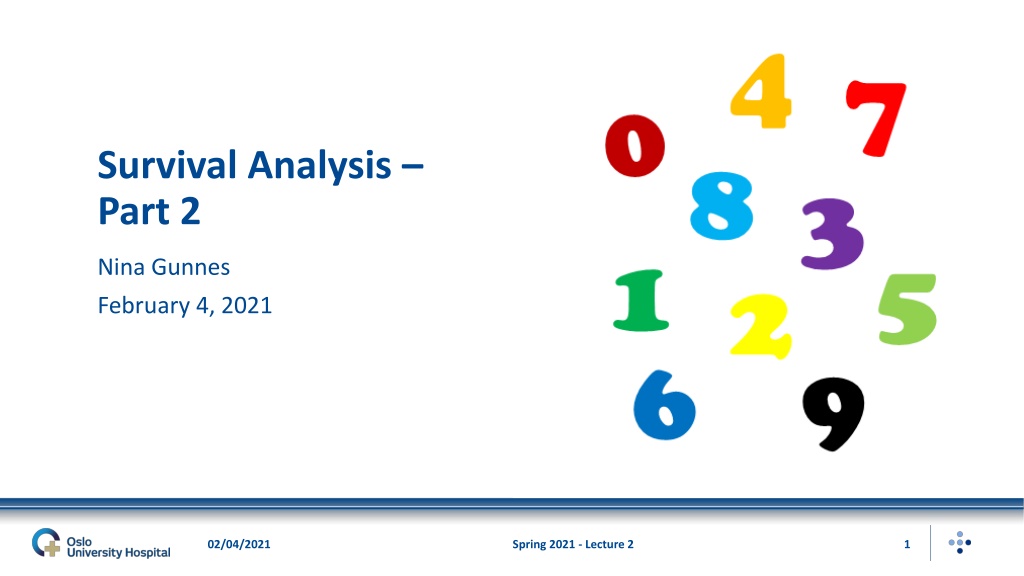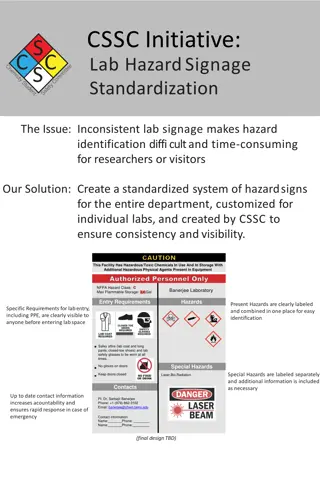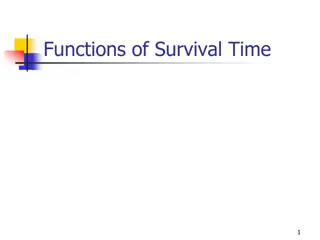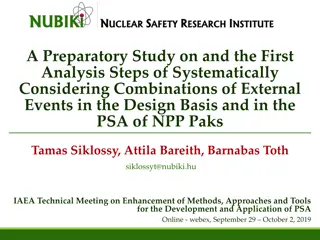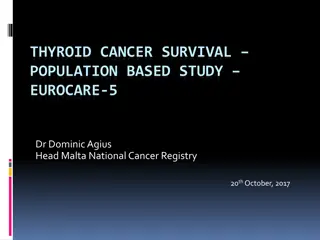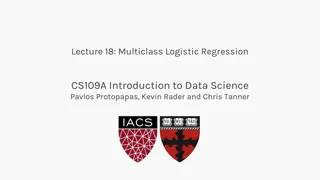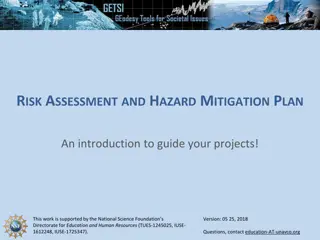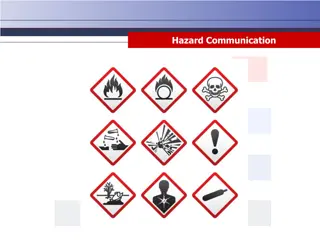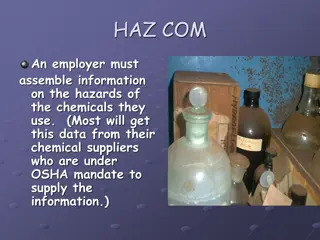Understanding Survival Analysis: Hazard Function and Cox Regression
Survival analysis examines hazards, such as the risk of events occurring over time. The Hazard Function and Cox Regression are essential concepts in this field. The Hazard Function assesses the risk of an event in a short time interval, while Cox Regression, named after Sir David Cox, estimates the impact of risk factors on survival time, without making assumptions about the distribution of survival times. This analysis involves regression coefficients and hazard ratios to understand relative risks between groups. It is a powerful tool widely used in biostatistics but requires careful interpretation to avoid pitfalls.
Download Presentation

Please find below an Image/Link to download the presentation.
The content on the website is provided AS IS for your information and personal use only. It may not be sold, licensed, or shared on other websites without obtaining consent from the author. Download presentation by click this link. If you encounter any issues during the download, it is possible that the publisher has removed the file from their server.
E N D
Presentation Transcript
Survival Analysis Part 2 Nina Gunnes February 4, 2021 02/04/2021 Spring 2021 - Lecture 2 1
Hazard function Central in survival analysis Closely related to the survival curve Expressing risk of dying in a short interval divided by length of interval ? = lim ? 0 ? Based on the conditional probability of survival Instantaneous risk (per unit of time) of dying at time ?, given survival up to ? Related to the probability density function and the survival function ? ? ?<?+ ?|? ? , where ? is the survival time 02/04/2021 Spring 2021 - Lecture 2 2
Cox regression Named after the British statistician Sir David Cox Cox (1972) Also know as proportional-hazards regression Estimating the effect of potential risk factors on survival time One of the most widely used (and misused) methods in biostatistics Many traps to fall into No assumption about the distribution of survival times 02/04/2021 Spring 2021 - Lecture 2 3
Cox regression, cont. Two strong assumptions Constant effects of risk factors over time Linear effects of risk factors on a logarithmic scale Using the hazard function, ? , as the dependent variable How does the hazard function depend on the risk factors? General formula: ? = 0? ??1?1+?2?2+ +???? ?1,?2, ,??: independent variables (risk factors) 0? : baseline hazard (i.e., hazard function when all ?? s are equal to 0) 02/04/2021 Spring 2021 - Lecture 2 4
Cox regression, cont. Aiming to estimate the regression coefficients: ?1, ?2, , ?? ?1: estimated effect of the 1strisk factor ?2: estimated effect of the 2ndrisk factor ??: estimated effect of the ?thrisk factor Linear effect of risk factors by taking the logarithm of the formula Often a very suitable regression model for survival data But not always! 02/04/2021 Spring 2021 - Lecture 2 5
Cox regression, cont. Defining the hazard ratio between two (groups of) subjects ?? = 1? 2?= 0? ??1?11+ +???1? Independent of time and baseline hazard (ref. proportional hazards) Comparing subjects differing only on the value of the ?thrisk factor ?1? ?2?(e.g., tumor thickness of malignant melanoma) ?? = ??10+ +?? 10+???1? ?2?+??+10+ +??0= ????1? ?2? Interpreting the hazard ratio as a kind of relative risk 0? ??1?21+ +???2?= ??1?11 ?21+ +???1? ?2? 02/04/2021 Spring 2021 - Lecture 2 6
Cox regression, cont. Giving the regression coefficients in the form of hazard ratios Interpretation of results depending of the nature of the risk factor Positive (negative) sign of ? corresponding to increased (decreased) risk If assuming subjects differing only on a categorical variable ??equal to hazard ratio relative to the reference group If assuming subjects differing only on a continuous variable ??equal to hazard ratio corresponding to a one-unit increase ?? ?= ???equal to hazard ratio corresponding to an increase of ? units 02/04/2021 Spring 2021 - Lecture 2 7
Example: Primary biliary cirrhosis Considering data from a study on primary biliary cirrhosis (PBC) 312 patients diagnosed with cirrhosis Referral to Mayo Clinic between January 1974 and May 1984 Patients randomized to one of two groups DPCA (D-penicillamine) Placebo Patients followed until death or censoring End of study in July 1986 02/04/2021 Spring 2021 - Lecture 2 8
Example: Primary biliary cirrhosis, cont. 125 of 312 patients dead by the end of follow-up 65 patients in the DPCA group 60 patients in the placebo group Study described in Chapter 3 of the book by Laake et al. (2007) PBC data and variable description available for download at https://www.med.uio.no/imb/personer/vit/veierod/boker/epidemiol ogiske-og-kliniske-forskningsmetoder/datafiler/. 02/04/2021 Spring 2021 - Lecture 2 9
Example: Primary biliary cirrhosis, cont. 312 observations 6 variables case: ID number time: time of follow-up (in days) censor: status at the end of follow-up (0 censored, 1 dead) treatmen: treatment (0 placebo, 1 DPCA) age: age (in years) bilirubi: serum bilirubin (in mg/dl) 02/04/2021 Spring 2021 - Lecture 2 10
Example: Primary biliary cirrhosis, cont. Listing values of variables 15 first observations 02/04/2021 Spring 2021 - Lecture 2 11
Example: Primary biliary cirrhosis, cont. Declaring survival-time data Time of follow-up given by time Failure event given by censor 02/04/2021 Spring 2021 - Lecture 2 12
Example: Primary biliary cirrhosis, cont. New variables generated _st: indicator for inclusion _d: indicator for event of interest _t: survival time _t0: time of entry into analysis 02/04/2021 Spring 2021 - Lecture 2 13
Example: Primary biliary cirrhosis, cont. Fitting a simple Cox proportional-hazards regression model Only including treatmen Obtaining crude (i.e., unadjusted) effect estimate of included risk factor Fitting a multiple Cox proportional-hazards regression model Including treatmen Including age Including bilirubi Obtaining adjusted effect estimates of included risk factors 02/04/2021 Spring 2021 - Lecture 2 14
Example: Primary biliary cirrhosis, cont. 02/04/2021 Spring 2021 - Lecture 2 15
Example: Primary biliary cirrhosis, cont. 02/04/2021 Spring 2021 - Lecture 2 16
Example: Primary biliary cirrhosis, cont. Similar results for treatment effect in crude and adjusted analyses Balanced treatment groups due to randomization Risk increased by 6% for patients in DPCA group Adjusted for age and serum bilirubin Risk increased by 4% for each one-year increase of age Adjusted for treatment and serum bilirubin Risk increased by 16% for each increase of 1 mg/dl of serum bilirubin Adjusted for treatment and age 02/04/2021 Spring 2021 - Lecture 2 17
Example: Primary biliary cirrhosis, cont. Testing PH assumption Based on Schoenfeld residuals Statistically significant result PH assumption violated 02/04/2021 Spring 2021 - Lecture 2 18
Example: Primary biliary cirrhosis, cont. Drawing log-log plots of survival Nominal and ordinal variables Adjustment for covariates Non-parallel curves PH assumption violated In Stata: stphplot command 02/04/2021 Spring 2021 - Lecture 2 19
References Aalen OO, Frigessi A, Moger TA, Scheel I, Skovlund E, Veier d MB. Statistiske metoder i medisin og helsefag. Oslo: Gyldendal akademisk; 2006. Cox DR. Regression Models and Life-Tables. J R Stat Soc Series B Stat Methodol. 1972;34(2):187 220. https://doi.org/10.1111/j.2517- 6161.1972.tb00899.x. Laake P, Hjart ker A, Thelle DS, Veier d MB. Epidemiologiske og kliniske forskningsmetoder. Oslo: Gyldendal akademisk; 2007. https://www.med.uio.no/imb/forskning/publikasjoner/boker/2007/epide miolgiske-kliniske-forskningsmetoder.html. 02/04/2021 Spring 2021 - Lecture 2 20
